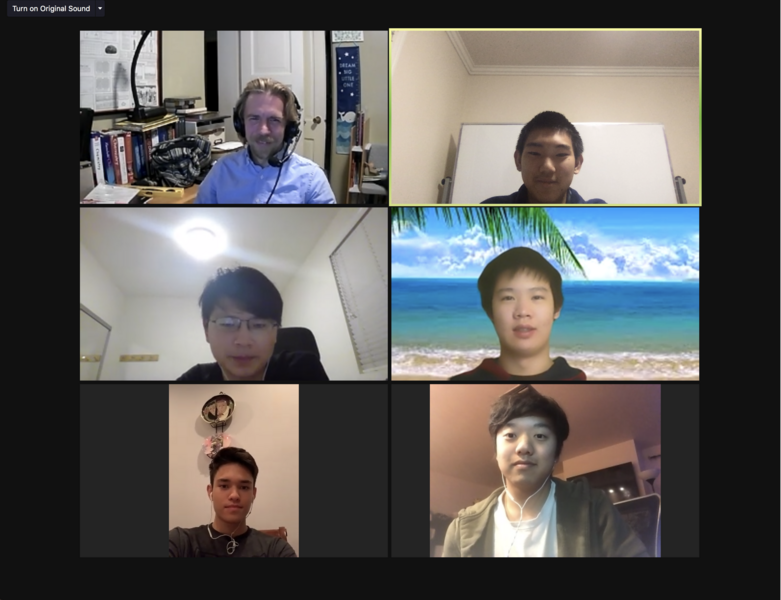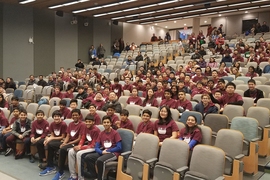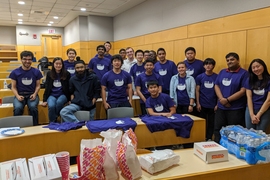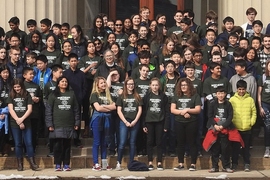Researchers in the Baker group at MIT are studying the mechanisms of proteins that catalyze protein unfolding, which often involves large conformational changes. Which technique can be used to actively monitor these protein conformational changes?
A) Förster Resonance Energy Transfer
B) Fluorescence In Situ Hybridization
C) Fluorescence Recovery After Photobleaching
D) Mass Spectrometry
If you chose A, you might have stood a chance at the second annual MIT Science Bowl Invitational. On Nov. 7, 192 high school students logged in to their computers for the event, where they competed to answer trivia questions like this one.
Amidst the Covid-19 pandemic, the event took on a completely virtual format, enabling 40 high school teams — almost twice as many teams as attended last year — to join in on the fun. Teams registered from locations as far as California and Hawaii. For the first time, the organizers spent six weeks writing all of the competition’s questions, including many about current research at MIT.
“Our volunteers and teams are as excited and motivated as ever to make these competitions happen,” says senior and economics major Paolo Adajar, the president of MIT Science Bowl. “And even though things are virtual, interest in science is not something that will go away. People will inevitably be excited about science.”
Going virtual
Ten MIT students organized and planned this fall’s high school invitational.
Last year’s inaugural invitational welcomed 24 teams, mostly from the Northeast, to MIT’s campus. Adajar expected about the same number to register this year. However, the virtual format led to an explosion of interest from across the country. “We had almost 80 teams register,” Adajar says. “We wondered, ‘How do we accommodate this many teams?’ So we expanded our recruitment for volunteers as much as we could.”
Thirty MIT students volunteered on the day of the event, helping teams get logged into the correct Zoom links at the correct times, and serving as scorekeepers and judges. The event also required an additional 50 non-MIT affiliated volunteers, including Science Bowl alumni and friends of MIT students. Organizers and volunteers communicated throughout the day via Slack.
The event, sponsored by the School of Science, began at 9 a.m. with a morning full of fast-paced, round-robin-style competitions. Teams broke out into Zoom rooms to compete against one another for a spot in the afternoon competition, which was double-elimination style.
“Once it was far enough into the competition and we got to the point where it was one match happening at a time, we livestreamed those matches to all competitors to recreate the feeling of sitting in an auditorium and watching those matches,” Adajar says. “Just some amount of watching it all happen is pretty fun. It’s nice even to just watch the live chat go on and see all of these dozens of high school students, who are very excited about science, discussing answers among themselves.”
Asking the tough questions
Because last year was the first invitational the club hosted, the group had been mostly focused on learning the ropes of hosting a large high school event. They used a list of Science Bowl questions curated by the U.S. Department of Energy to quiz participants. However, this year, the MIT Science Bowl Club decided to write the questions themselves.
“It’s very difficult to write good questions at a very high level of difficulty,” Adajar says. “But with the incredible people who are students here at MIT, and the number of Science Bowl alum that go to this school, if there's any place in the world that could write questions of high difficulty and with a very high caliber, it's going to be us.”
Junior and mathematics major Mihir Singhal, treasurer of the MIT Science Bowl, worked with a group of around 15 MIT students to write more than 1,000 questions. The questions spanned six disciplines: math, biology, chemistry, physics, Earth and space science, and an additional category that touched on MIT-based research.
“We decided to write the questions this year because we thought it would be cool to integrate MIT and also to be able to use new questions that haven't been used before,” Singhal says. Both Adajar and Singhal participated in Science Bowl competitions in middle and high school.
A new format brings new challenges
While the remote competition allowed for more volunteers and students to participate remotely, the new format also posed a few unexpected logistical challenges. For one, at an in-person Science Bowl, competitors press buzzers to indicate that they have an answer to a question.
Initially, while planning this year’s event, Adajar wondered how it would be possible for two teams thousands of miles apart to buzz against each other in real-time.
But with a bit of problem-solving, the Science Bowl organizers discovered a platform called the Conventional Online Buzzer Application, which allowed participants to buzz in remotely without flaw. At the beginning of each round, all participants tested their buzzers.
In addition to overcoming technological challenges, Adajar, Singhal, and the organizing team had to get creative when thinking of ways to cultivate a fun, social atmosphere. Adajar said a special part of most Science Bowl competitions is the in-person bonding and camaraderie that takes place between students. Normally, in the weeks leading up to the event, the organizing team is busy ordering T-shirts and pizza for 100 students. This year, social planning for the event looked different.
“We definitely did design opportunities for teams to meet each other in more low-stakes settings than just the competition,” Adajar says. “We shared some contact information with teams in the afternoon so they could scrimmage each other just for fun.”
Ultimately, North Hollywood High School, located in Los Angeles, California, was this year’s winner.
The MIT Science Bowl Club also organizes a regional competition for middle schoolers every spring. Part of the U.S. Department of Energy’s national competition, winners of the Northeast Regional Science Bowl proceed to the annual National Science Bowl competition. While the middle school science bowl is coming up on its sixth year at MIT, last year was the first time the club hosted their informal 24-team high school invitational event on campus.









